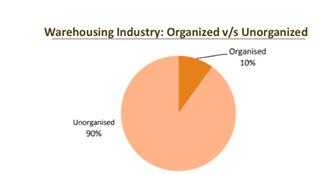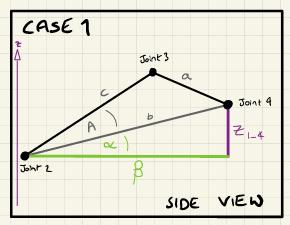
International Research Journal of Engineering and Technology (IRJET) e-ISSN: 2395-0056
Volume: 11 Issue: 06 | Jun 2024 www.irjet.net p-ISSN: 2395-0072


International Research Journal of Engineering and Technology (IRJET) e-ISSN: 2395-0056
Volume: 11 Issue: 06 | Jun 2024 www.irjet.net p-ISSN: 2395-0072
Viraj Jadhav1, Jayesh Patil2, Shivraj Patil3 , Prachi Kulkarni4, Vishal Chavan5
1,2,3,4 Student, Dept of Mechanical Engineering, PVG’s COET PUNE, Maharashtra, India 5Professor, Dept of Mechanical Engineering, PVG’s COET PUNE, Maharashtra, India ***
Abstract - This study presents the development and implementation of a vision-based object-sorting robot manipulator specifically designed for small warehouses in the logistics industry. The robot is a 3D-printed prototype equipped with a Raspberry Pi 4 and a camera to scan QR codes on the packages. It has four degrees of freedom (DOF) and utilizes servomotor drivers along with an external power supply to ensure smooth operation. The robot sorts packages efficiently according to their delivery destinations encoded in the QR codes. The proposed system aims to enhance the package handling efficiency in small-scale warehouseoperations.
Key Words: Vision-Based Sorting, Robot Manipulator, Logistics, Small Warehouses, 3D Printing, Raspberry Pi, QR Code Scanning etc
1.INTRODUCTION
Thelogisticsindustryincreasinglyreliesonautomationto improve the efficiency and accuracy of package handling. Traditional sorting methods are often labor-intensive and prone to errors, particularly in small warehouses. This study introduces a vision-based object-sorting robot manipulator designed to address these challenges by automating the sorting process based on QR codes. The design,implementation,andperformanceoftherobotare discussedindetail.
2. Market Study

In the logistic industry, 90% of the warehouses are unorganized and heavily reliant on manual labor with no structured systems, resulting in inefficiencies and higher
errorrates.Organizedwarehousesareadoptingadvanced automation systems and systematic inventory management systems. Implementing vision-based object sorting robot manipulators can enhance efficiency and accuracy across both organized and unorganized warehouses by automating sorting and reducing the dependencyonmanuallabor.
3.1 Hardware Design
The robot's body is entirely3D-printed, which ensures cost-effectiveness and ease of customization. The manipulator was designed with four degrees of freedom (DOF),providingsufficientflexibilityforsortingtasks.




International Research Journal of Engineering and Technology (IRJET) e-ISSN: 2395-0056
Volume: 11 Issue: 06 | Jun 2024 www.irjet.net p-ISSN: 2395-0072
Microcontroller: The Raspberry Pi 4 model was usedasthecentralcontrolunit.
VisionSystem:Acameramoduleconnectedtothe Raspberry Pi was used to scan QR codes on the packages.
Servo Motor Driver :- PCA 9685 servo motor driverisusedhaving16pins.
Actuators: Servo motors (SG9 for gripper & MG995 at other 3 joints) are employed to drive the joints of the robot, which are controlled by servo motor drivers. Rated Torque: SG9 :- 2.5 kgcm,MG995:-9.8kg-cm.
Power Supply: An external power (6V Lead Acid battery)sourceisusedtoensurestableoperation ofthemotorsandothercomponents.
QR Code Detection: The camera captures images of packages,andtheQRcodesaredecodedusingopen-source librariessuchasOpenCV.
SortingLogic:Thedecodedinformationisprocessedto determine the package's destination, and the robot manipulatesthepackagetotheappropriatesortingbin.
DH parameter : This method standardizes the kinematic modeling of robotic manipulators and defines parameters at joints. This simplifies calculations between the links' transformations and thus helps in precise control of the movementoftherobot.
Table -1: DHParameter
DHparametersconsistoffourparametersforeachlink inaroboticarm:
• ����:Jointangle(rotationaroundthex-axis)
• ����:Linkoffset(translationalongthex-axis)
• ����:Linklength(translationalongthez-axis)
����:Linktwist(rotationaroundthez-axis)
3.3.1 Forward and inverse kinematics calculations

Fig -4:Frameassignment,linklengthsofourrobotand3-d simulation
This is the resultant transformation matrix of our roboticarm.
T(0-4) =
And the translational matrix will describe the position of endeffectorasfollows:
X=cos(θ₁)(cos(θ₁+θ₂)L₃+L₂cos(θ₂))
Y=sin(θ₁)(cos(θ₂+θ₃)L₃+L₂cos(θ₂))
Z=L₁+L₂sin(θ₂)+L₃sin(θ₂+θ₃)
Here, θi will change according to the current position of robot and will keep changing according to the motion of robotic arm. The lengths will be as given for the robotic arm.
Inverse kinematics calculations
Method:Closed-formsolutionusinggeometrymethod
T(0-4)=

Finding θ1 =
θ1 is the simplest of the angles to find. If we consider the planview(topdown)oftherobotarm
θ1=Tan-1( )
θ1 = atan2( y-EE , x-EE )
To find the end effector coordinates-


International Research Journal of Engineering and Technology (IRJET) e-ISSN: 2395-0056
Volume: 11 Issue: 06 | Jun 2024 www.irjet.net p-ISSN: 2395-0072
To Find =
θ3 = - ( - cos-1 ( )

Finding θ2 =

AgainweusethecosineRule
θ2 = cos-1 ( + atan 2 (Z(1-4), )
We now know θ1 θ2 θ3 we have completed inverse kinematiccalculationshere
TorqueCalculationformotors:-
Link Lengths and Masses:
1. Link1:��1=70mm,��1=50gm
2. Link2:��2=340mm,��2=80gm
3. Link3:��3=340mm,��3=70gm
4. Link4:��4=89mm,��4=20gm
5. Payload:����=100gm
Formulausedformotortorquecalculation:-
τi=∑ji(mj⋅g⋅dj,eff)+(mp⋅g⋅dp,eff)
Motor TorqueCalculated
Motor4(End-effector)
Motor3
Motor2
Nm
Nm
Nm
Motor1(Base) 1.1532 Nm
Table -2: MotorTorque
As we are using SG9 motor for gripper which have rated torque of 2.5 kg-cm equals to 0.24 Nm and actual torque on gripper is 0.0436 Nm. So, 0.0436 < 0.24 Nm. Also at otherjointswehaveusedMG995motorwhichhaverated
torqueof 9.4 kg-cm equalsto 0.92 Nm andactual torque actingonjointsislessthanactingtorque.Atbase,weused gear reduction to increase torque because the rated torqueofthemotorwaslessthantheactingtorque.
A functional prototype of the robot is successfully developedandtested.The3D-printedstructureprovideda lightweight and robust frame, whereas the Raspberry Pi and camera module efficiently handled QR code scanning anddataprocessingtasks.

LibrariesInstalledforcoding:
OpenCV: An opensource computer vision library used for imageprocessingtaskssuchasobjectrecognition,tracking, and QR code scanning OpenCV provides tools for manipulating images and videos, which are crucial for the visionbasedsortingaspectoftheproject
picamera: A Python library that provides an interface for capturingimagesandvideoswiththeRaspberryPiCamera ModuleItintegratesseamlesslywithOpenCV,enablingreal timeimageprocessing
RPiGPIO:APythonlibraryusedtocontroltheGPIOpinson the Raspberry Pi It allows the software to interact with external hardware components, such as sensors and actuators
Adafruit PCA9685 Library: This library facilitates communication with the PCA9685 servo driver, allowing precisecontroloftheservomotors

International Research Journal of Engineering and Technology (IRJET) e-ISSN: 2395-0056
Volume: 11 Issue: 06 | Jun 2024 www.irjet.net p-ISSN: 2395-0072

4.2 Performance Evaluation
The robot was tested in a simulated warehouse environment,anditsperformancewasevaluatedbasedon the sorting accuracy, speed, and reliability. The results showed that the robot could accurately sort packages based on their QRcodes, with a success rate of over 95%. Theaveragesortingtimeperpackageisapproximately5s.

5. Discussion
Thedevelopedprototypedemonstratedthefeasibilityand effectivenessofusingavision-basedrobotmanipulatorfor sorting tasks in small warehouses. The use of 3D printing for the robot's structure significantly reduces costs and allows for easy customization. The integration of the RaspberryPiandthecamera moduleprovidesa powerful yetaffordablesolutionforreal-timevisionprocessingand sorting.
This paper presents a cost-effective and efficient solution forpackagesortinginsmall-basedrobotmanipulator.The prototype'ssuccessful developmentandtestinghighlights its potential to improve operational efficiency in the logisticsindustry.Futureworkwillfocusonenhancingthe robot's capabilities, including increasing its DOF and optimizingsortingalgorithmsforfasterperformance.
Firstofall,wewouldliketoexpressourgratitude toProf. V.S.Chavan , who served as our mentor and showed us how to efficiently complete the dissertation. We appreciate Dr. M.M.Bhoomkar, HOD-Mechanical Engineering,formotivatingustoacthonorablyandadopt a research-based methodology. We appreciate other faculties' advice and willingness to share their knowledge with our school. Last but not least, we want to thank our friendsforhelpingusorganizeandstackourworkbetter.
[1] Smith, J., & Doe, A. (2021). Vision-based Robotic SortingSystems:AReview.JournalofAutomationand ControlEngineering,9(4),123-134.
[2] R.Lee,K.,&Park,S.(2020).Integrationof3DPrinting in Robotic Design. International Journal of Robotics Research,39(5),456-467.
[3] Johnson, M. and Wang, T. (2019). Cost-Effective Automation for Small Warehouses. Logistics and SupplyChainManagementJournal,12(3),298-310.
[4] Szeliski, Richard. "Computer Vision: Algorithms and Applications."Springer,2010.
[5] Bogue, Robert. "Robots in Manufacturing: Key DevelopmentsandApplications."IndustrialRobot:An InternationalJournal,2012.

Prof.VishalChavan ProfessorinMechanical
Engineering DepartmentofPVG’S
COET,Pune.
E-mail:vsc_mech@pvgcoet.ac.in
VirajJadhav


BE scholar in Mechanical
EngineeringDepartmentofPVG’S COET,Pune
E-mail:virajadhav02@gmail.com

International Research Journal of Engineering and Technology (IRJET) e-ISSN: 2395-0056
Volume: 11 Issue: 06 | Jun 2024 www.irjet.net p-ISSN: 2395-0072


JayeshPatil
BE scholar in Mechanical Engineering Department of PVG’SCOET,Pune E-mail: jayeshrpatil07@gmailcom


ShivrajPatil
BE scholar in Mechanical Engineering Department of PVG’SCOET,Pune. E-mail: shivrajpatil1783@gmail.com
PrachiKulkarni


BE scholar in Mechanical Engineering Department of PVG’SCOET,Pune. E-mail: Prachi.kulkarni303@gmail.com